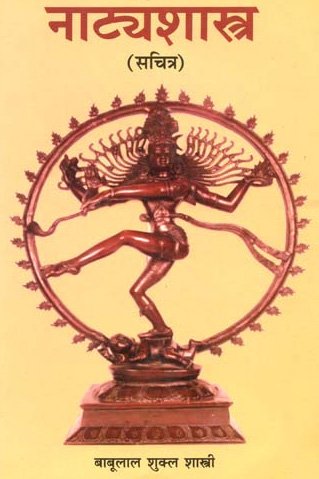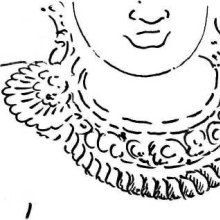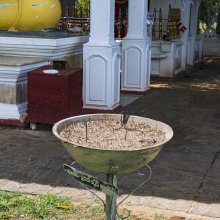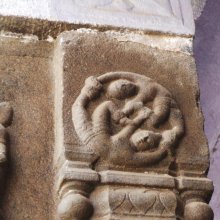Giving: 1 definition
Introduction:
Giving means something in Hinduism, Sanskrit. If you want to know the exact meaning, history, etymology or English translation of this term then check out the descriptions on this page. Add your comment or reference to a book if you want to contribute to this summary article.
Images (photo gallery)
(+18 more images available)
In Hinduism
Natyashastra (theatrics and dramaturgy)
Source: Shodhganga: Elements of Art and Architecture in the Trtiyakhanda of the Visnudharmottarapurana (natya)Giving (offerings) is associated with Puṣpahasta: one of the thirteen Combined-hand Gestures (in Indian Dramas) (known as saṃyuktahastas), according to the Viṣṇudharmottarapurāṇa, an ancient Sanskrit text which (being encyclopedic in nature) deals with a variety of cultural topics such as arts, architecture, music, grammar and astronomy.—According to the Viṣṇudharmottarapurāṇa, in puṣpapuṭa posture, both hands are joined together by their sides and the fingers of both hands should be in sarpaśīrṣa position. In the Abhinayadarpaṇa, this posture is said to use in waving beams in front of the image of god, as an act of adoration, taking of water, fruit etc, giving offerings, evening and a flower invested with magical power.

Natyashastra (नाट्यशास्त्र, nāṭyaśāstra) refers to both the ancient Indian tradition (shastra) of performing arts, (natya—theatrics, drama, dance, music), as well as the name of a Sanskrit work dealing with these subjects. It also teaches the rules for composing Dramatic plays (nataka), construction and performance of Theater, and Poetic works (kavya).
See also (Relevant definitions)
Ends with: Alms Giving.
Full-text (+3391): Dana, Pradana, Kanyadana, Annadana, Parityaga, Arpaṇa, Kanyapradana, Danavyatyasa, Adatri, Upajalpin, Apidana, Parityajana, Dada, Varira, Parivarjana, Pratidana, Abda, Bahudugdha, Datri, Pratipadana.
Relevant text
Search found 483 books and stories containing Giving; (plurals include: Givings). You can also click to the full overview containing English textual excerpts. Below are direct links for the most relevant articles:
Manusmriti with the Commentary of Medhatithi (by Ganganatha Jha)
Verse 3.158 < [Section VIII - Śrāddhas]
Verse 3.202 < [Section XII - Vessels to be used at Śrāddhas]
Verse 3.95 < [Section VII - Duties of the Householder]
Jnaneshwari (Bhavartha Dipika) (by Ramchandra Keshav Bhagwat)
Verse 11.53 < [Chapter 11 - Vishvarupa-darshana-yoga]
Verse 17.21 < [Chapter 17 - Shraddha-traya-vibhaga-yoga]
Verse 18.58 < [Chapter 18 - Moksha-sannyasa-yoga]
Vaisheshika-sutra with Commentary (by Nandalal Sinha)
Sūtra 10.2.8 (Observances produce adṛṣṭa as their fruit,...) < [Chapter 2 - Of Other Forms of Cognition]
Sūtra 6.1.10 (Preference, should be given to worthy recipients afterwards) < [Chapter 1 - Of Vedic Duties]
Sūtra 10.1.7 (An objection answered) < [Chapter 1 - Of the Attributes of the Soul]
The Doctrine of Paticcasamuppada (by U Than Daing)
Chapter 12 - Paticcasamuppada In Reverse Order
Chapter 7 - Paticcasamuppada Samsara Is Revolving All The Time
Chapter 11 - He Who Follows The Way Of Paticcasamuppada Follows The Way Of The Blind.
Vinaya Pitaka (1): Bhikkhu-vibhanga (the analysis of Monks’ rules) (by I. B. Horner)
The Great Chronicle of Buddhas (by Ven. Mingun Sayadaw)
(1) First Pāramī: The Perfection of Generosity (dāna-pāramī) < [Chapter 6 - On Pāramitā]
Part 1 - Definition of Pāramī < [Chapter 1-3 - Anudīpanī on words and phrases]
Part 2 - King Pasenadī Kosala’s Alms-giving (asadisa-dāna) < [Chapter 35 - Story of Māra]
Related products
(+65 more products available)











